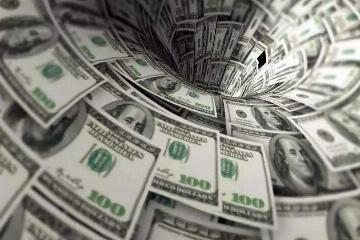Strong Dollar Pressures Global Currencies Despite Fed Cuts
Advertisements
In the complex world of international finance, interest rates serve as the compass that guides the value of currenciesTypically, when a central bank lowers interest rates, the attractiveness of a currency diminishes, leading to depreciationHowever, the most recent actions taken by the Federal Reserve (the Fed) painted a different picture for the U.Sdollar, which surprisingly remained strong even after a series of rate cutsThis phenomenon can be attributed to a stark contrast in interest rates between the United States and other countriesAs noted, following three rate reductions, the one-year deposit rate in the U.Sstill stood at an impressive 3.7 percent, while the Eurozone lagged behind at 3.1 percent, China at 1.35 percent, and Japan almost at zeroSuch disparity in rates has made U.Sdollar-denominated assets increasingly attractive to global investors seeking higher yields, ultimately fueling demand for the dollar itself and pushing its value upward.
When considering the broader global economic landscape, it is evident that growth is far from uniform
Advertisements
For instance, projections suggest that the Eurozone's GDP will grow by a mere 1.2 percent in 2024, with individual countries like France and Germany (the latter facing a technical recession) and Japan grappling with stagnant economic conditionsEmerging markets, too, exhibit signs of weakness and instabilityConversely, the U.Seconomy, while not without its challenges, demonstrates relatively strong performance amidst growing global uncertaintiesConsequently, the dollar solidifies its position as the world's primary reserve currency and a safe haven assetIn light of these dynamics, risk-averse investors are increasingly opting to hold onto dollars rather than venturing into currencies from nations with fragile economic foundations, which experience significant depreciation in their value.
The structural advantages of the U.Sdollar cannot be overlookedAs the largest economy globally, the United States benefits from an inherent strength that other nations struggle to match
Advertisements
Initiatives such as tax cuts and efforts to bring manufacturing jobs back have successfully attracted substantial foreign direct investment to the U.SAdditionally, the American dollar’s dominance in global trade is underscored by the fact that it accounts for approximately 60 percent of international transactionsThis entrenched position creates a scenario where many countries find themselves reliant on the dollar, reinforcing its strengthEven in the wake of the Fed's rate cuts, this structural robustness helps maintain the dollar’s value while other currencies falter.
Another critical aspect that influences currency value is market sentimentThe Federal Reserve's monetary policies wield significant clout over financial markets worldwideDespite the recent spree of rate cuts, investor confidence in the long-term stability of the U.Seconomy and the dollar remains intactHistorically, the U.S
Advertisements
has held a dominant stance in the economic and financial arenas, fostering ingrained beliefs about its ability to self-correct and adaptFurthermore, during periods of rate reductions, the Fed strategically communicates hints of a return to hawkish policies, indicating a possible slowdown in the pace of future cutsThis has helped to stabilize market expectations surrounding the dollar, encouraging investors to continue holding or even increasing their dollar positions instead of divesting massively in response to the cutsSuch behaviors lead to a reinforcement of the dollar’s position in the global market, while other nations’ currencies often experience sharp declines due to underlying economic instabilities that erode investor confidence.
Focusing on emerging markets offers another lens through which to understand the implications of a strong dollarThese nations typically rely heavily on external financing, making them particularly vulnerable to fluctuations in currency values
- Stocks on Brink? Fed Rate Hike Debate Heats Up
- Transaction Banks Tap Platform Strategy for Growth
- Strong Demand for Global Electric Vehicle Market
- Treasury Yields Hit New Low Amid Wealth Shift
- Crossroads of Wealth: Where Do You Stand?
The strength of the dollar often escalates the cost of servicing foreign debts for these countriesIn 2024, for example, the Brazilian real depreciated by 21 percent, while the Turkish lira and the Mexican peso both lost 16 percent against the dollar; the Russian ruble fell by 15 percentSuch significant drops in local currencies exacerbate the debt burdens in these countries, leading to heightened pressure on repayment obligationsTo manage these rising costs, domestic capital tends to flow out, creating a vicious cycle that further depreciates their currenciesAgainst the backdrop of the Federal Reserve's interest rate cuts, many emerging market currencies have witnessed dramatic declines.
Looking towards the future, while the dollar’s short-term strength is evident, it is important to recognize the long-term challenges posed by mounting debt levels in the United StatesAs of 2024, the U.S

national debt has exceeded $36 trillion, constituting a staggering 125 percent of GDPFurthermore, the trend of de-dollarization—the movement of countries away from reliance on the dollar—appears to be intensifying, which could pose a significant threat to the dollar's long-standing supremacyMeanwhile, for nations experiencing substantial currency depreciation, the repercussions could manifest as inflation, capital flight, and a range of economic challengesConsequently, these countries will need to implement appropriate measures to stabilize their currencies and economies.
In conclusion, the resilience of the U.Sdollar amid interest rate cuts by the Federal Reserve can primarily be attributed to a combination of favorable interest rate differentials, overall economic strength, and structural advantages within both the U.Seconomy and its currencyNonetheless, both short- and long-term challenges loom on the horizon, not just for the U.S